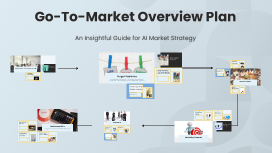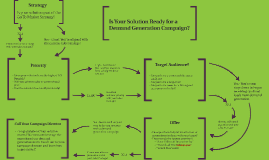Go-To-Market Overview Plan
Transcript: Assets Go-To-Market Overview Plan An Insightful Guide for AI Market Strategy Comment Purpose of the Presentation Identifying Key Segments This presentation aims to outline a comprehensive Go-To-Market strategy for our AI solutions. It provides insights into market dynamics, target audience identification, and execution plans, ensuring alignment among stakeholders for a successful launch. Benefits to Customers Key segments can be identified using demographic, psychographic, and behavioral criteria. This segmentation aids in tailoring marketing messages and product offerings to specific audience needs, thus improving outreach effectiveness. The benefits to customers clarify how the product or service solves their problems or improves their situation. This includes cost savings, increased efficiency, enhanced user experience, and overall satisfaction that lead to loyalty and advocacy. Overview of Go-To-Market Strategy Introduction to Go-To-Market Strategy A Go-To-Market strategy is a blueprint that outlines how a company will sell its products or services to customers. It encompasses market research, target audience analysis, and competitive positioning, ensuring that offerings meet market demands effectively. Understanding the core components of a Go-To-Market (GTM) strategy is crucial for success in today's competitive landscape. A well-structured GTM plan ensures that a product or service reaches the right audience effectively and efficiently. Competitive Differentiators Understanding Customer Needs Competitive differentiators represent aspects that make your offering more appealing than alternatives. This could include pricing advantages, product customization, or faster delivery options that align with customer expectations and needs. Importance of Market Planning Target Audience Effective market planning is essential for minimizing risks and maximizing opportunities. It allows businesses to anticipate market trends, assess consumer behavior, and strategically allocate resources, ultimately leading to better decision-making and increased profitability. Gathering insights into customer needs can be achieved through surveys, interviews, and competitive analysis. Understanding pain points and desires is crucial in tailoring products that resonate with the target audience. Understanding the target audience is vital for a successful go-to-market strategy. Identifying customer segments, understanding their needs, and creating detailed personas can significantly enhance engagement and conversion efforts. Value Proposition A strong value proposition articulates how your product or service uniquely fulfills customer needs, setting you apart from competitors. It includes unique selling points, competitive differentiators, and outlines clear benefits for customers. Unique Selling Points Personas and Buyer Journey The unique selling points (USPs) highlight features that are not offered by competitors, providing specific advantages to the customer. Examples include proprietary technology, superior performance, or unprecedented customer service, which can effectively attract target audiences. Creating buyer personas involves compiling demographic, behavioral, and motivational data that reflects various customer types. Mapping out the buyer journey helps identify touchpoints and refine marketing strategies based on customer interactions. Partnerships and Collaborations Traditional Marketing Approaches Strategic partnerships can amplify marketing efforts by tapping into new customer bases. Collaborations with complementary brands allow for shared resources and extended reach, enhancing overall market presence. Traditional marketing includes methods like print media, television, and radio advertising. Despite the digital shift, these approaches remain valuable for building brand credibility and reaching wider audiences offline. Sales Strategy Key Performance Indicators A robust sales strategy is crucial for translating market insights into revenue. It defines how to convert leads into customers, maximizing the potential of the sales team to achieve business objectives. Digital Marketing Strategies Metrics and KPIs Lead Generation Techniques Sales Process Overview Key performance indicators are measurable values that demonstrate how effectively a company achieves key business objectives. Common KPIs for go-to-market strategies include customer acquisition cost, lifetime value, conversion rates, and market share. Digital marketing encompasses various tactics such as SEO, content marketing, and social media engagement. These methods allow brands to reach specific demographics, enhancing customer interactions through targeted ads and analytics-driven campaigns. Effective measurement is crucial in determining the success of a go-to-market strategy. By setting clear key performance indicators (KPIs), organizations can track performance, optimize processes, and adjust strategies for continuous improvement. The sales process

















